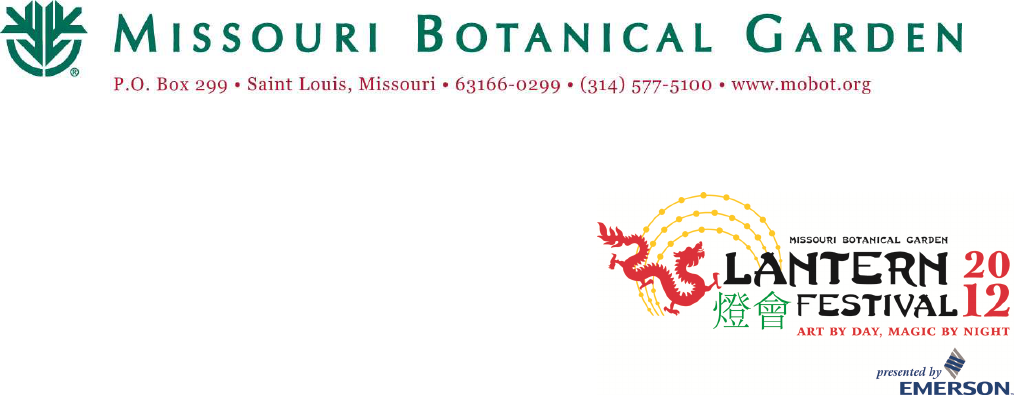
“LANTERN FESTIVAL: ART BY DAY, MAGIC BY NIGHT”
Lantern Design and Assembly
A team of skilled designers, engineers and artisans are hard at
work behind the scenes to make the spectacular lantern
installations displayed at the Missouri Botanical Garden
during the “Lantern Festival: Art by Day, Magic by Night” exhibition.
Work initiates in the LanternFest
®
offices in Zigong, a city regarded as the
“lantern-making capital” of China. Every piece is custom-designed and requires detailed
engineering work. It all begins with a picture of the desired scene or object to be transformed
into a lantern installation.
LanternFest Managing Director Spencer Tan will sit down with his art department—a team of
experienced graphic designers and engineers—to study and analyze the picture. Together, they carefully
consider various factors that must be determined for each piece: size, scale, movement, motors, power
needs and more. Every exhibition site is different, and therefore also has its own special considerations.
Designers must take into account the contours of the land, how the structure will be anchored to the
ground and the available power feeds. All of these decisions will go into the creation of a technical sheet.
On average, it takes the team about four weeks to come up with this master plan for each individual
lantern set or scene. The technical sheet is paired with a graphic rendering; together they form the visual
basis of each lantern set for the client.
LanternFest has designed lanterns to look like everything from modern art to world places; it all depends
on what the client wants. “Most lantern sets fit into themes. We can build a lantern from any picture,” said
Joe Tavares, production consultant for “Lantern Festival: Art by Day, Magic by Night.”
Once the visuals are approved, construction can begin. Staff members are divided into two or three teams.
A three-team unit can produce roughly 30 sets for a show. Each LanternFest team engages in two to three
weeks of intense work to assemble a materials sheet of everything required to construct their assigned
lantern sets. They consider the types of supplies, quantities, weight, spacing and the lantern’s motif as
they compile their notes, which are detailed down to the inch. Then the team works on materials
procurement. Very traditional materials are used in the lantern scenes—upcycled porcelain dishes and
medicine bottles, satins and all-natural cocoon-shell silks in 300, 600 and 900 thread counts. Quality is
important, as the silks chosen must be able to withstand months outdoors before fading.
The second stage of construction involves local production in China. The teams typically have about one
month to assemble as many of the raw-form sets as possible into linear forms. Artisans refer to the
technical sheet and computer-generated graphic renderings for each set and “enlarge” the design to scale
by drawing in chalk on asphalt; Tavares refers to this technique as “old world meets new world.”
The team will follow the chalk outline of each design with steel rods, bending and molding into one- and
two-dimensional pieces that will eventually be joined together as the framework for a three-dimensional
lantern. As many individual shapes and frames as possible are made in advance. About 40 to 50 of these
pre-fabricated pieces can fit inside a 40-foot-wide shipping container. An exhibition of the size of
“Lantern Festival: Art by Day, Magic by Night” requires four of these containers to transport the many
parts necessary to create the detailed, large-scale lantern scenes (some of which range in size up to three
stories tall). The containers travel by boat from China to the U.S.

Once the pieces are on site, the three-dimensional assembly of the final product can begin. All electrical
wiring within each display piece must be connected. Silk pieces are draped over the metal armature and
adhered with a special type of glue. An ornamental gold trim is added to hide the adhesive lines. Some
silk pieces or trim may be seamed together on site with sewing machines or by hand. Some silks are
sprayed with paint for added detail and dimension, and all pieces are reviewed for any finishing touch ups
to make them more real.
Tan explains that this art of lantern-making is often a family affair. “Lantern training is learned from
generation to generation,” he said. “Fathers as ‘teachers’ pass their knowledge down to sons, but there are
also some younger people getting into the trade.”
As for the final result of their work?
“It’s like taking a trip to China in St. Louis,” said Tavares. “The experience and totality of the lantern sets
engulf you. The size, the lights, the colors—you could not have imagined what this cultural experience is
about until you see it for yourself. The sets for the Missouri Botanical Garden exhibition rival any of
those you’d see in Zigong (China).”
For more information, contact the Public Relations Department at (314) 577-0254 or (314) 577-5141 or
check the Garden’s Lantern Festival website at www.mobot.org/lanternfestival. For 24-hour recorded
visitor information, call (314) 577-5100 or 1-800-642-8842 toll free.
The Missouri Botanical Garden’s mission is “to discover and share knowledge about plants and their
environment, in order to preserve and enrich life.” Today, 153 years after opening, the Missouri Botanical
Garden is a National Historic Landmark and a center for science and conservation, education and
horticultural display.
Rev. 4/12/12
